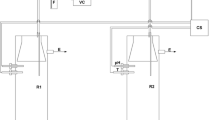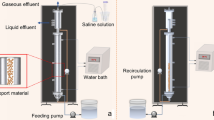Abstract
The use of high purity oxygen as a feeding gas in microbial fermentation has recent gained huge attention in industrial scale process due to its advantageous effect to increase viable cell density as well as target metabolite productivity. However, usage of highly pure oxygen is currently too expensive for industrialization. To overcome this limitation, off-gas recycle pressure swing adsorption (PSA) was employed which assist in continuous production of high purity oxygen during fermentation process. The off-gas from fermentation process contained about 70 ∼ 80% oxygen which was re-utilized as the input gas in PSA, whereas conventional PSA process utilized air with 21% oxygen content. This difference in the oxygen content of the input gas decreased the size of PSA, resulting in reduction of equipment costs. Using the characteristics of off-gas recycle PSA, we analyzed and compared the economic feasibility of a highly pure oxygen supplying strategy for the production of poly(3-hydroxybutyrate) (PHB) by Ralstonia eutropha based on previously reported data, using both air and highly pure oxygen. To achieve annual production of 3,630 tonnes of PHB the aforementioned method was adopted, by doing so the production cost of PHB was significantly reduced to 4.2 $/kg. While, the conventional process (utilizing air as the feeding gas) resulted in the highest cost (5.9 $/kg). The low cost of off-gas recycle PSA was due to reduction of fixed capital cost, which was about 3 times lower than that of the conventional fermentation process. Therefore, the production cost of fermentation was considerably decreased by using a highly pure oxygen supplying strategy based on off-gas recycle PSA.
Similar content being viewed by others
References
Shang, L., M. Jiang, C. H. Ryu, H. N. Chang, S. H. Cho, and J. W. Lee (2003) Inhibitory effect of carbon dioxide on the fedbatch culture of Ralstonia eutropha: Evaluation by CO2 pulse injection and autogenous CO2 methods. Biotechnol. Bioeng. 83: 312–320.
Shang, L., P. Y. Tian, N. J. Kim, H. N. Chang, and M. S. Hahm (2009) Effects of oxygen supply modes on the production of human growth hormone in different scale bioreactors. Chem. Eng. Technol. 32: 600–605.
Riesenberg, D. and R. Guthke (1999) High-cell density cultivation of microorganisms. Appl. Microbiol. Biotechnol. 51: 422–430.
Ryu, H. W., S. K. Hahn, Y. K. Chang, and H. N. Chang (1997) Production of poly(3-hydroxybutyric acid) by high cell density fed-batch culture of Alcaligenes eutrophus with phosphate limitation. Biotechnol. Bioeng. 55: 28–32.
Han, S. J., H. N. Chang, and J. Lee (1998) Fed-batch cultivation of an oxygen-dependent inducible promoter system, the nar promoter in Escherichia coli with an inactivated nar operon. Biotechnol. Bioeng. 59: 400–406.
Han, S. J., H. N. Chang, J. A. DeMoss, E. J. Suh, and J. Lee (2000) Development and characterization of an oxygen-dependent inducible promoter system, the modified nar promoter in a mutant Escherichia coli. Biotechnol. Bioeng. 68: 115–120.
Han, S. J., H. N. Chang, and J. Lee (2001) Characterization of an oxygen-dependent inducible promoter, the nar promoter of Escherichia coli, to utilize in metabolic engineering. Biotechnol. Bioeng. 72: 573–576.
Chang, H. N., S. J. Han, S. C. Yim, M. R. Han, and J. Lee (2002) Fed-batch cultures of Escherichia coli cells with oxygendependent nar promoter systems. Adv. Biochem. Eng. Biotechnol. 74: 171–181.
Han, M. R., L. Shang, H. N. Chang, S. J. Han, Y. C. Kim, and J. Lee (2006) Fermentation characteristics of a low-oxygen inducible hmp promoter system in Bacillus subtilis LAB1886. J. Chem. Technol. Biotecnol. 81: 1071–1074.
Liu, Y. and J. H. Tay (2001) Strategy for minimization of excess sludge production from the activated sludge process. Biotechnol. Adv. 19: 97–107.
Pinheiro, R., I. Bero, and M. Mota (2003) Growth and β-galactosidase activity in cultures of Kluyveromyces marxianus under increased air pressure. Lett. Appl. Microbiol. 37: 438–442.
Yang, J. D. and N. S. Wang (1992) Oxygen mass transfer enhancement via fermentor headspace pressurization. Biotechnol. Prog. 8: 244–251.
Pinheiro, R., I. Bero, and M. Mota (1997) Physiological behavior of Saccharomyces cerevisiae under increased air and oxygen pressures. Biotechnol. Lett. 19: 703–708.
Bero, I. and M. Mota (1998) Batch and fed-batch cultures of E. coli TB1 at different oxygen transfer rates. Bioproc. Biosyst. Eng. 18: 451–455.
Chang, H. N. and J. H. Seo (2001) Biochemical Engineering 2nd edition, pp. 316, Akademi Press (ISSN 89-7616-225-0), Seoul, Korea.
Gas Separation Systems. http://www.grasys.com.
Giddey, S., F. T. Ciacchi, and S. P. S. Badwal (2010) High purity oxygen production with a polymer electrolyte membrane electrolyser. J. Membrane Sci. 346: 227–232.
He, Y., X. Zhu, Q. Li, and W. Yang (2009) Perovskite oxide absorbents for oxygen separation. AIChE J. 55: 3125–3133.
Choi, J. I. and S. Y. Lee (1997) Process analysis and economic evaluation for poly(3-hydroxybutyrate) production by fermentation. Bioproc. Biosyst. Eng. 17: 335–342.
Choi, J. I. and S. Y. Lee (2000) Economic considerations in the production of poly(3-hydroxybutyrate-co-3-hydroxyvalerate) by bacterial fermentation. Appl. Microbiol. Biotechnol. 53: 646–649.
Chang, H. N., B. J. Kim, C. M. Jeong, J. W. Kang, and J. K. Park (2008) Multi-stage CSTR bioreactor system equipped with cell recycle unit. PCT WO 2008/091113 A1 (USA, pending; Korean patent 10-0834110)
Byrom, D. (1987) Polymer synthesis by microorganisms: Technology and economics. Trends Biotechnol. 5: 246–250.
Lee, S. Y. (1996) Plastic bacteria? Progress and prospects for poly-hydroxyalkanoate production in bacteria. Trends Biotechnol. 14: 431–438.
Witholt, B. and B. Kessler (1999) Perspectives of medium chain length poly(hydroxyalkanoates), a versatile set of bacterial bioplastics. Curr. Opin. Biotechnol. 10: 279–285.
Author information
Authors and Affiliations
Corresponding author
Rights and permissions
About this article
Cite this article
Chang, H.N., Kim, M.I., Fei, Q. et al. Economic evaluation of off-gas recycle pressure swing adsorption (PSA) in industrial scale poly(3-hydroxybutyrate) fermentation. Biotechnol Bioproc E 15, 905–910 (2010). https://doi.org/10.1007/s12257-010-0114-z
Received:
Accepted:
Published:
Issue Date:
DOI: https://doi.org/10.1007/s12257-010-0114-z




